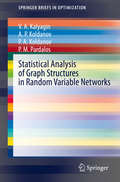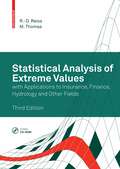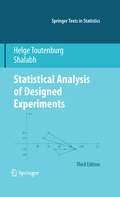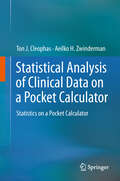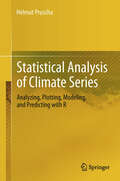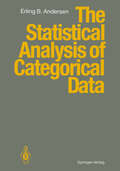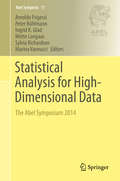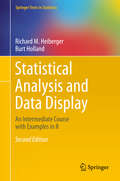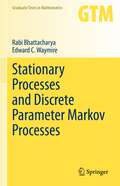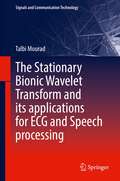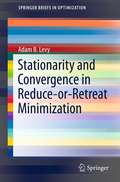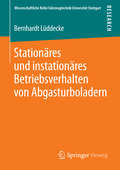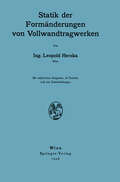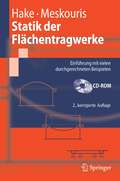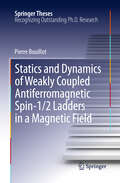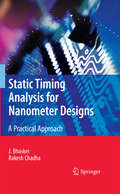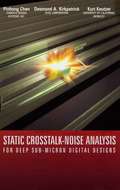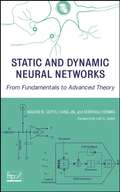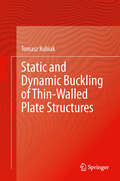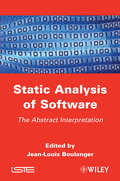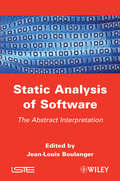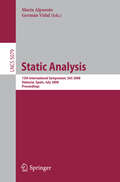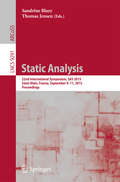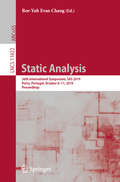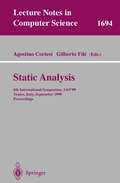- Table View
- List View
Statistical Analysis of Graph Structures in Random Variable Networks (SpringerBriefs in Optimization)
by V. A. Kalyagin A. P. Koldanov P. A. Koldanov P. M. PardalosThis book studies complex systems with elements represented by random variables. Its main goal is to study and compare uncertainty of algorithms of network structure identification with applications to market network analysis. For this, a mathematical model of random variable network is introduced, uncertainty of identification procedure is defined through a risk function, random variables networks with different measures of similarity (dependence) are discussed, and general statistical properties of identification algorithms are studied. The volume also introduces a new class of identification algorithms based on a new measure of similarity and prove its robustness in a large class of distributions, and presents applications to social networks, power transmission grids, telecommunication networks, stock market networks, and brain networks through a theoretical analysis that identifies network structures. Both researchers and graduate students in computer science, mathematics, and optimization will find the applications and techniques presented useful.
Statistical Analysis of Extreme Values: with Applications to Insurance, Finance, Hydrology and Other Fields
by Rolf-Dieter Reiss Michael ThomasStatistical analysis of extreme data is vital to many disciplines including hydrology, insurance, finance, engineering and environmental sciences. This book provides a self-contained introduction to parametric modeling, exploratory analysis and statistical interference for extreme values. For this Third Edition, the entire text has been thoroughly updated and rearranged to meet contemporary requirements, with new sections and chapters address such topics as dependencies, the conditional analysis and the multivariate modeling of extreme data. New chapters include An Overview of Reduced-Bias Estimation; The Spectral Decomposition Methodology; About Tail Independence; and Extreme Value Statistics of Dependent Random Variables.
Statistical Analysis of Designed Experiments, Third Edition (Springer Texts in Statistics)
by Helge Toutenburg ShalabhThis book is the third revised and updated English edition of the German textbook \Versuchsplanung und Modellwahl" by Helge Toutenburg which was based on more than 15 years experience of lectures on the course \- sign of Experiments" at the University of Munich and interactions with the statisticians from industries and other areas of applied sciences and en- neering. This is a type of resource/ reference book which contains statistical methods used by researchers in applied areas. Because of the diverse ex- ples combined with software demonstrations it is also useful as a textbook in more advanced courses, The applications of design of experiments have seen a signi?cant growth in the last few decades in di?erent areas like industries, pharmaceutical sciences, medical sciences, engineering sciences etc. The second edition of this book received appreciation from academicians, teachers, students and applied statisticians. As a consequence, Springer-Verlag invited Helge Toutenburg to revise it and he invited Shalabh for the third edition of the book. In our experience with students, statisticians from industries and - searchers from other ?elds of experimental sciences, we realized the importance of several topics in the design of experiments which will - crease the utility of this book. Moreover we experienced that these topics are mostly explained only theoretically in most of the available books.
Statistical Analysis of Clinical Data on a Pocket Calculator: Statistics on a Pocket Calculator
by Ton J. Cleophas Aeilko H. ZwindermanThe core principles of statistical analysis are too easily forgotten in today’s world of powerful computers and time-saving algorithms. This step-by-step primer takes researchers who lack the confidence to conduct their own analyses right back to basics, allowing them to scrutinize their own data through a series of rapidly executed reckonings on a simple pocket calculator. A range of easily navigable tutorials facilitate the reader’s assimilation of the techniques, while a separate chapter on next generation Flash prepares them for future developments in the field. This practical volume also contains tips on how to deny hackers access to Flash internet sites. An ideal companion to the author’s co-authored works on statistical analysis for Springer such as Statistics Applied to Clinical Trials, this monograph will help researchers understand the processes involved in interpreting clinical data, as well as being a necessary prerequisite to mastering more advanced statistical techniques. The principles of statistical analysis are easily forgotten in today’s world of time-saving algorithms. This step-by-step primer takes researchers back to basics, enabling them to examine their own data through a series of sums on a simple pocket calculator.
Statistical Analysis of Climate Series: Analyzing, Plotting, Modeling, and Predicting with R
by Helmut PruschaThe book presents the application of statistical methods to climatological data on temperature and precipitation. It provides specific techniques for treating series of yearly, monthly and daily records. The results’ potential relevance in the climate context is discussed.The methodical tools are taken from time series analysis, from periodogram and wavelet analysis, from correlation and principal component analysis, and from categorical data and event-time analysis.The applied models are - among others - the ARIMA and GARCH model, and inhomogeneous Poisson processes.Further, we deal with a number of special statistical topics, e.g. the problem of trend-, season- and autocorrelation-adjustment, and with simultaneous statistical inference.Programs in R and data sets on climate series, provided at the author’s homepage, enable readers (statisticians, meteorologists, other natural scientists) to perform their own exercises and discover their own applications.
The Statistical Analysis of Categorical Data
by Erling B. AndersenThe aim of this book is to give an up to date account of the most commonly uses statist i cal models for categoriCal data. The emphasis is on the connection between theory and appIications to real data sets. The book only covers models for categorical data. Various n:t0dels for mixed continuous and categorical data are thus excluded. The book is written as a textbook, although many methods and results are quite recent. This should imply, that the book can be used for a graduate course in categorical data analysis. With this aim in mind chapters 3 to 12 are concluded with a set of exer eises. In many cases, the data sets are those data sets, which were not included in the examples of the book, although they at one point in time were regarded as potential can didates for an example. A certain amount of general knowledge of statistical theory is necessary to fully benefit from the book. A summary of the basic statistical concepts deemed necessary pre requisites is given in chapter 2. The mathematical level is only moderately high, but the account in chapter 3 of basic properties of exponential families and the parametric multinomial distribution is made as mathematical preeise as possible without going into mathematical details and leaving out most proofs.
Statistical Analysis for High-Dimensional Data: The Abel Symposium 2014 (Abel Symposia #11)
by Arnoldo Frigessi Peter Bühlmann Ingrid K. Glad Mette Langaas Sylvia Richardson Marina VannucciThis book features research contributions from The Abel Symposium on Statistical Analysis for High Dimensional Data, held in Nyvågar, Lofoten, Norway, in May 2014. The focus of the symposium was on statistical and machine learning methodologies specifically developed for inference in “big data” situations, with particular reference to genomic applications. The contributors, who are among the most prominent researchers on the theory of statistics for high dimensional inference, present new theories and methods, as well as challenging applications and computational solutions. Specific themes include, among others, variable selection and screening, penalised regression, sparsity, thresholding, low dimensional structures, computational challenges, non-convex situations, learning graphical models, sparse covariance and precision matrices, semi- and non-parametric formulations, multiple testing, classification, factor models, clustering, and preselection. Highlighting cutting-edge research and casting light on future research directions, the contributions will benefit graduate students and researchers in computational biology, statistics and the machine learning community.
Statistical Analysis and Data Display: An Intermediate Course with Examples in R (Springer Texts in Statistics)
by Richard M. Heiberger Burt HollandThis contemporary presentation of statistical methods features extensive use of graphical displays for exploring data and for displaying the analysis. The authors demonstrate how to analyze data—showing code, graphics, and accompanying tabular listings—for all the methods they cover. Complete R scripts for all examples and figures are provided for readers to use as models for their own analyses.This book can serve as a standalone text for statistics majors at the master’s level and for other quantitatively oriented disciplines at the doctoral level, and as a reference book for researchers. Classical concepts and techniques are illustrated with a variety of case studies using both newer graphical tools and traditional tabular displays.New graphical material includes:an expanded chapter on graphicsa section on graphing Likert Scale Data to build on the importance of rating scales in fields from population studies to psychometricsa discussion on design of graphics that will work for readers with color-deficient visionan expanded discussion on the design of multi-panel graphicsexpanded and new sections in the discrete bivariate statistics capter on the use of mosaic plots for contingency tables including the n×2×2 tables for which the Mantel–Haenszel–Cochran test is appropriatean interactive (using the shiny package) presentation of the graphics for the normal and t-tables that is introduced early and used in many chapters
Stationary Processes and Discrete Parameter Markov Processes (Graduate Texts in Mathematics #293)
by Rabi Bhattacharya Edward C. WaymireThis textbook explores two distinct stochastic processes that evolve at random: weakly stationary processes and discrete parameter Markov processes. Building from simple examples, the authors focus on developing context and intuition before formalizing the theory of each topic. This inviting approach illuminates the key ideas and computations in the proofs, forming an ideal basis for further study. After recapping the essentials from Fourier analysis, the book begins with an introduction to the spectral representation of a stationary process. Topics in ergodic theory follow, including Birkhoff’s Ergodic Theorem and an introduction to dynamical systems. From here, the Markov property is assumed and the theory of discrete parameter Markov processes is explored on a general state space. Chapters cover a variety of topics, including birth–death chains, hitting probabilities and absorption, the representation of Markov processes as iterates of random maps, and large deviation theory for Markov processes. A chapter on geometric rates of convergence to equilibrium includes a splitting condition that captures the recurrence structure of certain iterated maps in a novel way. A selection of special topics concludes the book, including applications of large deviation theory, the FKG inequalities, coupling methods, and the Kalman filter. Featuring many short chapters and a modular design, this textbook offers an in-depth study of stationary and discrete-time Markov processes. Students and instructors alike will appreciate the accessible, example-driven approach and engaging exercises throughout. A single, graduate-level course in probability is assumed.
The Stationary Bionic Wavelet Transform and its Applications for ECG and Speech Processing (Signals and Communication Technology)
by Talbi MouradThis book first details a proposed Stationary Bionic Wavelet Transform (SBWT) for use in speech processing. The author then details the proposed techniques based on SBWT. These techniques are relevant to speech enhancement, speech recognition, and ECG de-noising. The techniques are then evaluated by comparing them to a number of methods existing in literature. For evaluating the proposed techniques, results are applied to different speech and ECG signals and their performances are justified from the results obtained from using objective criterion such as SNR, SSNR, PSNR, PESQ , MAE, MSE and more.
Stationarity and Convergence in Reduce-or-Retreat Minimization (SpringerBriefs in Optimization)
by Adam B. Levy Stationarity and Convergence in Reduce-or-Retreat Minimization presents and analyzes a unifying framework for a wide variety of numerical methods in optimization. The author’s “reduce-or-retreat” framework is a conceptual method-outline that covers any method whose iterations choose between reducing the objective in some way at a trial point, or retreating to a closer set of trial points. The alignment of various derivative-based methods within the same framework encourages the construction of new methods, and inspires new theoretical developments as companions to results from across traditional divides. The text illustrates the former by developing two generalizations of classic derivative-based methods which accommodate non-smooth objectives, and the latter by analyzing these two methods in detail along with a pattern-search method and the famous Nelder-Mead method.In addition to providing a bridge for theory through the “reduce-or-retreat” framework, this monograph extends and broadens the traditional convergence analyses in several ways. Levy develops a generalized notion of approaching stationarity which applies to non-smooth objectives, and explores the roles of the descent and non-degeneracy conditions in establishing this property. The traditional analysis is broadened by considering “situational” convergence of different elements computed at each iteration of a reduce-or-retreat method. The “reduce-or-retreat” framework described in this text covers specialized minimization methods, some general methods for minimization and a direct search method, while providing convergence analysis which complements and expands existing results.
Stationäres und instationäres Betriebsverhalten von Abgasturboladern (Wissenschaftliche Reihe Fahrzeugtechnik Universität Stuttgart)
by Bernhardt LüddeckeBernhardt Lüddecke bietet einen umfassenden Einblick in Kennfeldvermessung und Berechnung von Abgasturboladern. Mit experimentellen und numerischen Untersuchungen zur Aero-Thermodynamik sowie zu Reibungsverlusten und Wärmeströmen verdeutlicht er die Eigenschaften dieser kompakten Maschinen. Mithilfe einer neuartigen Drehmoment-Messtechnik konnte der Autor erstmals kurbelwinkelaufgelöst das momentane Drehmoment einer Abgasturboladerturbine geringer Baugröße unter realen motorischen Bedingungen ermitteln. Die vorliegende Studie erlaubt es, auf ein quasi-stationäres Turbinenverhalten auch unter pulsierender Beaufschlagung zu schließen, was für aussagekräftige Simulationen aufgeladener Motoren von wesentlicher Bedeutung ist.
Statik der Flächentragwerke: Einführung mit vielen durchgerechneten Beispielen (Springer-Lehrbuch)
by Erwin Hake Konstantin MeskourisInhalt dieser 2., korrigierten Auflage ist die Bestimmung der Schnittgrößen und Verformungen von Scheiben, Platten und Rotationsschalen (inkl. Einflussflächen für Platten, Kreisringe als Elemente von Schalentragwerken). Umfassend, ausführlich und anhand vieler Beispiele erläutern die Autoren alle Herleitungen und Anwendungen. Sie legen großen Wert auf praxisbezogene Hinweise und realitätsnahe Vereinfachungen. Besonders nützlich sind die Programmelemente auf CD, die der Übung wie dem praktischen Gebrauch dienen. Die CD ist unabhängig von Excel verwendbar und auch ohne Kenntnis des Programms einsetzbar. Plus: Zahlentafeln und Formeln im Anhang.
Statics and Dynamics of Weakly Coupled Antiferromagnetic Spin-1/2 Ladders in a Magnetic Field (Springer Theses)
by Pierre BouillotThis thesis shows how a combination of analytic and numerical techniques, such as a time dependent and finite temperature Density Matrix Renormalization Group (DMRG) technique, can be used to obtain the physical properties of low dimensional quantum magnets with an unprecedented level of accuracy. A comparison between the theory and experiment then enables these systems to be used as quantum simulators; for example, to test various generic properties of low dimensional systems such as Luttinger liquid physics, the paradigm of one dimensional interacting quantum systems. Application of these techniques to a material made of weakly coupled ladders (BPCB) allowed the first quantitative test of Luttinger liquids. In addition, other physical quantities (magnetization, specific heat etc.), and more remarkably the spins-spin correlations – directly measurable in neutron scattering experiments – were in excellent agreement with the observed quantities. We thus now have tools to quantitatiively assess the dynamics for this class of quantum systems.
Static Timing Analysis for Nanometer Designs: A Practical Approach
by J. Bhasker Rakesh Chadhaiming, timing, timing! That is the main concern of a digital designer charged with designing a semiconductor chip. What is it, how is it T described, and how does one verify it? The design team of a large digital design may spend months architecting and iterating the design to achieve the required timing target. Besides functional verification, the t- ing closure is the major milestone which dictates when a chip can be - leased to the semiconductor foundry for fabrication. This book addresses the timing verification using static timing analysis for nanometer designs. The book has originated from many years of our working in the area of timing verification for complex nanometer designs. We have come across many design engineers trying to learn the background and various aspects of static timing analysis. Unfortunately, there is no book currently ava- able that can be used by a working engineer to get acquainted with the - tails of static timing analysis. The chip designers lack a central reference for information on timing, that covers the basics to the advanced timing veri- cation procedures and techniques.
Static Crosstalk-Noise Analysis: For Deep Sub-Micron Digital Designs
by Pinhong Chen Desmond A. Kirkpatrick Kurt KeutzerAs the feature size decreases in deep sub-micron designs, coupling capacitance becomes the dominant factor in total capacitance. The resulting crosstalk noise may be responsible for signal integrity issues and significant timing variation. Traditionally, static timing analysis tools have ignored cross coupling effects between wires altogether. Newer tools simply approximate the coupling capacitance by a 2X Miller factor in order to compute the worst case delay. The latter approach not only reduces delay calculation accuracy, but can also be shown to underestimate the delay in certain scenarios. This book describes accurate but conservative methods for computing delay variation due to coupling. Furthermore, most of these methods are computationally efficient enough to be employed in a static timing analysis tool for complex integrated digital circuits. To achieve accuracy, a more accurate computation of the Miller factor is derived. To achieve both computational efficiency and accuracy, a variety of mechanisms for pruning the search space are detailed, including: -Spatial pruning - reducing aggressors to those in physical proximity, -Electrical pruning - reducing aggressors by electrical strength, -Temporal pruning - reducing aggressors using timing windows, -Functional pruning - reducing aggressors by Boolean functional analysis.
Static and Dynamic Neural Networks: From Fundamentals to Advanced Theory (Wiley - IEEE)
by Madan Gupta Liang Jin Noriyasu HommaProvides comprehensive treatment of the theory of both static and dynamic neural networks. * Theoretical concepts are illustrated by reference to practical examples Includes end-of-chapter exercises and end-of-chapter exercises. *An Instructor Support FTP site is available from the Wiley editorial department.
Static and Dynamic Buckling of Thin-Walled Plate Structures
by Tomasz KubiakThis monograph deals with buckling and postbuckling behavior of thin plates and thin-walled structures with flat wall subjected to static and dynamic load. The investigations are carried out in elastic range.The basic assumption here is the thin plate theory. This method is used to determination the buckling load and postbuckling analysis of thin-walled structures subjected to static and dynamic load. The book introduces two methods for static and dynamic buckling investigation which allow for a wider understanding of the phenomenon. Two different methods also can allow uncoupling of the phenomena occurring at the same time and attempt to estimate their impact on the final result.A general mathematical model, adopted in proposed analytical-numerical method, enables the consideration of all types of stability loss i.e.local, global and interactive forms of buckling. The applied numerical-numerical method includes adjacent of walls, shear-lag phenomenon and a deplanation of cross-sections.
Static Analysis of Software: The Abstract Interpretation (Iste Ser.)
by Jean-Louis BoulangerThe existing literature currently available to students and researchers is very general, covering only the formal techniques of static analysis. This book presents real examples of the formal techniques called "abstract interpretation" currently being used in various industrial fields: railway, aeronautics, space, automotive, etc. The purpose of this book is to present students and researchers, in a single book, with the wealth of experience of people who are intrinsically involved in the realization and evaluation of software-based safety critical systems. As the authors are people currently working within the industry, the usual problems of confidentiality, which can occur with other books, is not an issue and so makes it possible to supply new useful information (photos, architectural plans, real examples).
Static Analysis of Software: The Abstract Interpretation
by Jean-Louis BoulangerThe existing literature currently available to students and researchers is very general, covering only the formal techniques of static analysis. This book presents real examples of the formal techniques called "abstract interpretation" currently being used in various industrial fields: railway, aeronautics, space, automotive, etc. The purpose of this book is to present students and researchers, in a single book, with the wealth of experience of people who are intrinsically involved in the realization and evaluation of software-based safety critical systems. As the authors are people currently working within the industry, the usual problems of confidentiality, which can occur with other books, is not an issue and so makes it possible to supply new useful information (photos, architectural plans, real examples).
Static Analysis: 15th International Symposium, SAS 2008, Valencia, Spain, July 16-18, 2008, Proceedings (Lecture Notes in Computer Science #5079)
by María Alpuente Germán Vidal-OriolaThis book constitutes the refereed proceedings of the 15th International Symposium on Static Analysis, SAS 2008, held in Valencia, Spain in July 2008 - co-located with LOPSTR 2008, the International Symposium on Logic-based Program Synthesis and Transformation, PPDP 2008, the International ACM SIGPLAN Symposium on Principles and Practice of Declarative Programming, and PLID 2008, the International Workshop on Programming Language Interference and Dependence. The 22 revised full papers presented together with two invited lectures were carefully reviewed and selected from 63 submissions. The papers address all aspects of static analysis including abstract domains, abstract interpretation, abstract testing, compiler optimizations, control flow analysis, data flow analysis, model checking, program specialization, security analysis, theoretical analysis frameworks, type based analysis, and verification systems.
Static Analysis: 22nd International Symposium, SAS 2015, Saint-Malo, France, September 9-11, 2015, Proceedings (Lecture Notes in Computer Science #9291)
by Sandrine Blazy Thomas JensenThis book constitutes the refereed proceedings of the 22nd International Static Analysis Symposium, SAS 2015, held in Saint-Malo, France, in September 2015. The 18 papers presented in this volume were carefully reviewed and selected from 44 submissions. All fields of static analysis as a fundamental tool for program verification, bug detection, compiler optimization, program understanding, and software maintenance are addressed, featuring theoretical, practical, and application advances in the area
Static Analysis: 26th International Symposium, SAS 2019, Porto, Portugal, October 8–11, 2019, Proceedings (Lecture Notes in Computer Science #11822)
by Bor-Yuh Evan ChangThis book constitutes the refereed proceedings of the 26th International Symposium on Static Analysis, SAS 2019, held in Porto, Portugal, in October 2019. The 20 regular papers presented in this book were carefully reviewed and selected from 50 submissions. The papers are grouped in topical sections on pointers and dataflow; languages and decidability; numerical; trends: assuring machine learning; synthesis and security; and temporal properties and termination.
Static Analysis: 6th International Symposium, SAS'99, Venice, Italy, September 22-24, 1999, Proceedings (Lecture Notes in Computer Science #1694)
by Agostino Cortesi Gilberto FileStatic analysis is increasingly recognized as a fundamental reasearch area aimed at studying and developing tools for high performance implementations and v- i cation systems for all programming language paradigms. The last two decades have witnessed substantial developments in this eld, ranging from theoretical frameworks to design, implementation, and application of analyzers in optim- ing compilers. Since 1994, SAS has been the annual conference and forum for researchers in all aspects of static analysis. This volume contains the proceedings of the 6th International Symposium on Static Analysis (SAS’99) which was held in Venice, Italy, on 22{24 September 1999. The previous SAS conferences were held in Namur (Belgium), Glasgow (UK), Aachen (Germany), Paris (France), and Pisa (Italy). The program committee selected 18 papers out of 42 submissions on the basis of at least three reviews. The resulting volume o ers to the reader a complete landscape of the research in this area. The papers contribute to the following topics: foundations of static analysis, abstract domain design, and applications of static analysis to di erent programming paradigms (concurrent, synchronous, imperative, object oriented, logical, and functional). In particular, several papers use static analysis for obtaining state space reduction in concurrent systems. New application elds are also addressed, such as the problems of security and secrecy.
